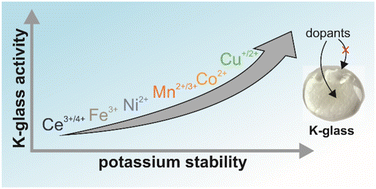Catalytic removal of soot particles over potassium glasses – the effect of doping with aliovalent redox metals†
Abstract
Low-cost, noble metal-free and environmentally friendly potassium glasses constitute a new class of promising catalysts for soot combustion. The effect of doping of potassium silicate glasses with aliovalent metals of prominent redox properties (Mn, Fe, Co, Ni, Cu, Ce) on their catalytic performance in soot combustion was investigated. A series of glasses were synthesized by the melt-quenching method and characterized in terms of composition, structure, and morphology by a plethora of techniques. The structural verification by XRD, FTIR, and RS confirmed the amorphous structure of all investigated samples. High hydroxylation and carboxylation of the surface of glassy materials were observed by DRIFT. The chemical state of metal additives in the doped samples was determined by XPS and UV/vis-DR as Mn2+/3+, Fe3+, Co2+/3+, Ni2+, Cu+/2+, and Ce3+/4+. The typical morphology of glasses obtained by the high-temperature method was observed in SEM images. Thermal stability tests by SR-TAD permitted us to order the dopants as follows: Cu > undoped > Co ≫ Mn > Ni > Fe ≈ Ce, corresponding to a decreasing stability of potassium in the investigated glasses. Catalytic activity was investigated under both tight and loose contact conditions, in an atmosphere of NO or without this additive. The investigated materials exhibited high activity in soot combustion (T50 = 359–386 °C for tight contact and 442–500 °C for loose contact). The most promising dopants were Cu and Co, based on their activity and potassium stability. The low surface concentration of redox metals suggested that they influenced activity towards the modification of the glass structure rather than playing a role of active centers in the soot oxidation. Those dopants also influenced the formation and stability of potassium carbonates on the surface of the investigated glasses. A correlation between the observed thermal stability of surface potassium species and catalytic activity was established.



 Please wait while we load your content...
Please wait while we load your content...